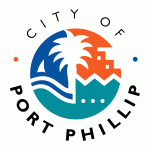City of Port Phillip (Port Phillip)
 |
Port Phillip contains a number of varied and substantial retail, entertainment and leisure precincts. These include Bay Street (Port Melbourne), Victoria Avenue (Albert Park), Clarendon Street (South Melbourne), Armstrong Street (Middle Park), Fitzroy Street (St Kilda), Acland Street (St Kilda), Carlisle Street (Balaclava) and Ormond Road (Elwood). A number of significant employment areas lie within Port Phillip, including part of the St Kilda Road business district and industrial, warehousing and manufacturing districts in South Melbourne and Port Melbourne. The city has experienced a significant amount of residential development in the 1990s, particularly in areas close to the foreshore. Port Phillip is well served by public transport with a substantial tram network, the St Kilda and Port Melbourne tram lines and two stations on the Sandringham railway line, in addition to bus services.
Comprising three multi member wards, it is predominantly an amalgamation of three former cities – St Kilda, parts of South Melbourne, most of Port Melbourne, as well as a small portion of Windsor from the former City of Prahran
The city was created with its present borders in June 1994 under the municipal restructure by the state government. It is bounded by White Reserve and Todd Road to the west, the West Gate Freeway, Kings Way and Dorcas Street to the north, St Kilda Road, High Street, Punt Road, Queens Way, Dandenong Road, Orrong Road, Inkerman Street, Hotham Street, Glen Huntly Road, St Kilda Street and Head Street generally to the east and the foreshore of Port Phillip to the south. Adjacent councils include the City of Melbourne, City of Bayside, City of Glen Eira and the City of Stonnington. When first created, the city was administered by three appointed commissioners, headed by Des Clarke. The first council elections were held in March 1996.
Council offices are currently located in the St Kilda Town Hall, Port Melbourne Town Hall and the South Melbourne Town Hall. The council operates several other facilities including local libraries, child care centres, parks, playgrounds and community centres. In 2020 ANAM was given a long lease to South Melbourne Town Hall and council staff there and a few community groups vacated the building.
* Albert Park Primary School (Government)
* Elwood Primary School (Government)
* Galilee Regional Primary School (Catholic)
* Middle Park Primary School (Government)
* Port Melbourne Primary School (Government)
Map - City of Port Phillip (Port Phillip)
Map
Country - Australia
 |
 |
| Flag of Australia | |
The ancestors of Aboriginal Australians began arriving from south east Asia approximately 65,000 years ago, during the last ice age. Arriving by sea, they settled the continent and had formed approximately 250 distinct language groups by the time of European settlement, maintaining some of the longest known continuing artistic and religious traditions in the world. Australia's written history commenced with the European maritime exploration of Australia. The Dutch navigator Willem Janszoon was the first known European to reach Australia, in 1606. In 1770, the British explorer James Cook mapped and claimed the east coast of Australia for Great Britain, and the First Fleet of British ships arrived at Sydney in 1788 to establish the penal colony of New South Wales. The European population grew in subsequent decades, and by the end of the 1850s gold rush, most of the continent had been explored by European settlers and an additional five self-governing British colonies established. Democratic parliaments were gradually established through the 19th century, culminating with a vote for the federation of the six colonies and foundation of the Commonwealth of Australia on 1 January 1901. Australia has since maintained a stable liberal democratic political system and wealthy market economy.
Currency / Language
| ISO | Currency | Symbol | Significant figures |
|---|---|---|---|
| AUD | Australian dollar | $ | 2 |
| ISO | Language |
|---|---|
| EN | English language |















